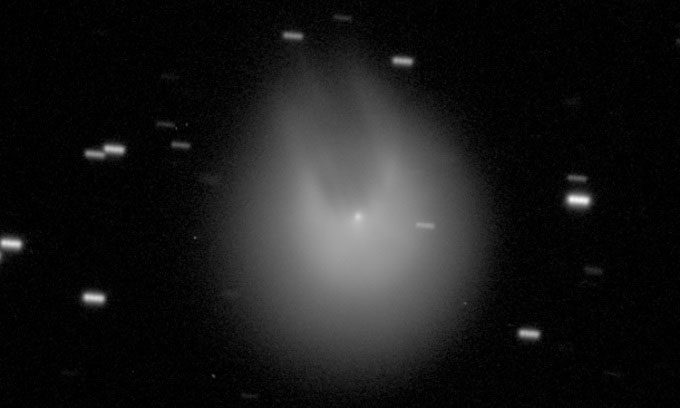A comet the size of a city, named 12P/Pons–Brooks, is approaching its closest point to Earth on a 71-year orbit around the Solar System.
An unusual volcanic comet heading towards the Sun appears to have developed “horns” after it exploded, making it shine like a small star and ejecting super-cold “magma” into space. This is the first time researchers have observed this comet erupting in nearly 70 years.

Comet 12P/Pons-Brook (12P) in a photo taken on July 26. (Photo: Comet Chasers/Richard Miles)
Comet 12P/Pons-Brooks (12P) is a cold volcanic comet. Like all other comets, this icy celestial body consists of a solid nucleus containing a mixture of ice, dust, and gas, surrounded by a gas cloud known as the comet’s coma. However, unlike most comets, the gas and ice within the nucleus of 12P have accumulated to such an extent that it can explode violently, ejecting cold material known as icy magma through large cracks in its crust.
On July 20, several astronomers detected a massive outburst from the comet, causing it to suddenly brighten approximately 100 times more than usual, according to Spaceweather.com. This increase in brightness occurred as the comet’s crust unexpectedly swelled with gas and ice crystals released from within, allowing it to reflect more sunlight down to Earth.
By July 26, the comet’s large crust had expanded to a diameter of 230,000 km, over 7,000 times wider than the nucleus, which has a diameter of 30 km, Richard Miles, a researcher at the British Astronomical Association and a specialist in cold volcanic comets, reported. Interestingly, the unusual shape of the expanding crust made the comet appear to have horns. Other experts compared the distorted comet to the Millennium Falcon, one of the famous starships from the Star Wars franchise.
The unusual shape of the comet’s crust is likely due to deformation in the nucleus of 12P. The gas escaping may be partially obstructed by protrusions on the nucleus, forming a V-shape in the crust. As the gas continues to move away from the comet, the V-shape becomes more pronounced. However, eventually, the expanded crust will dissipate as the gas and ice become too dispersed to reflect sunlight.
According to Miles, this is the first major eruption detected from 12P in 69 years, primarily because its orbit keeps it too far from Earth for observation. 12P takes about 71 years to complete its orbit around the Sun. During this time, it is pushed to the farthest edge of the Solar System. This comet will reach its closest point to the Sun on April 21, 2024, and its closest point to Earth on June 2, 2024, where it may be visible to the naked eye in the night sky.
In addition to 12P, researchers have recorded several eruptions from 29P/Schwassmann-Wachmann (29P) in recent years, the most volatile volcanic comet in the Solar System. In December 2022, astronomers witnessed the largest eruption from 29P in 12 years, ejecting about one million tons of cold magma into space.


















































